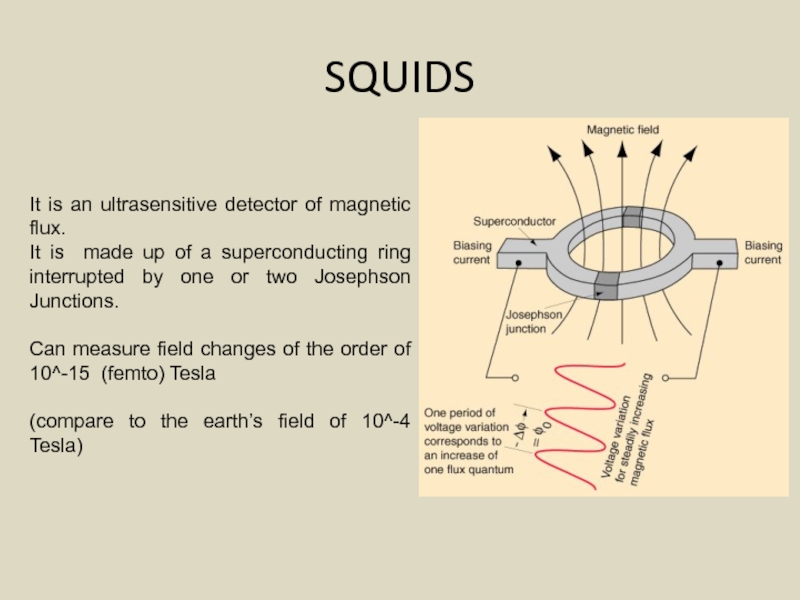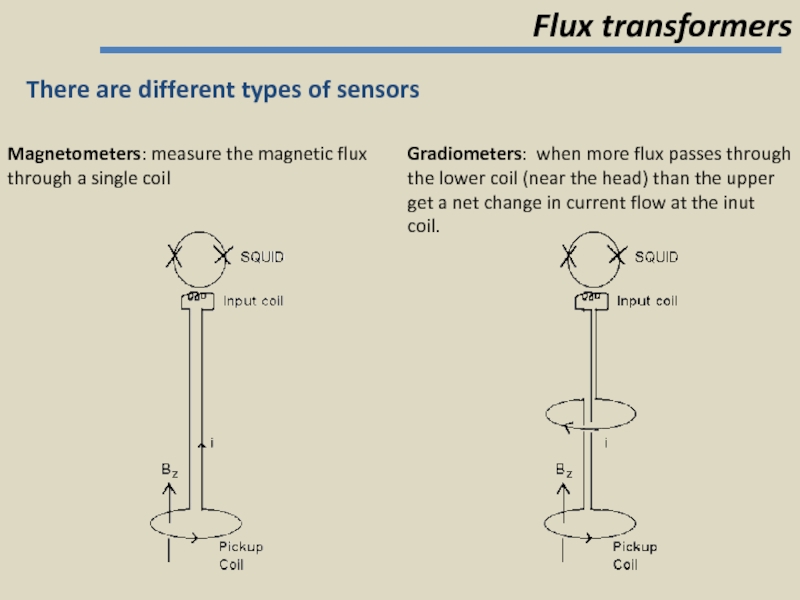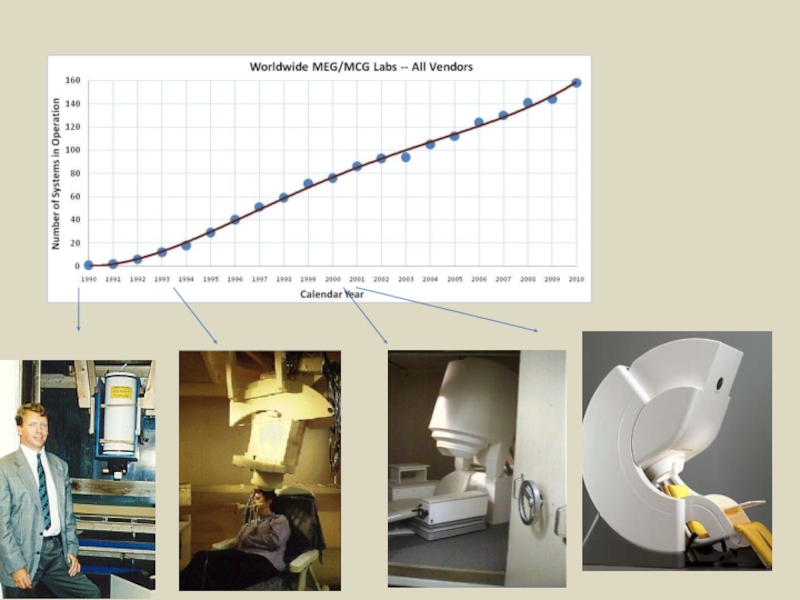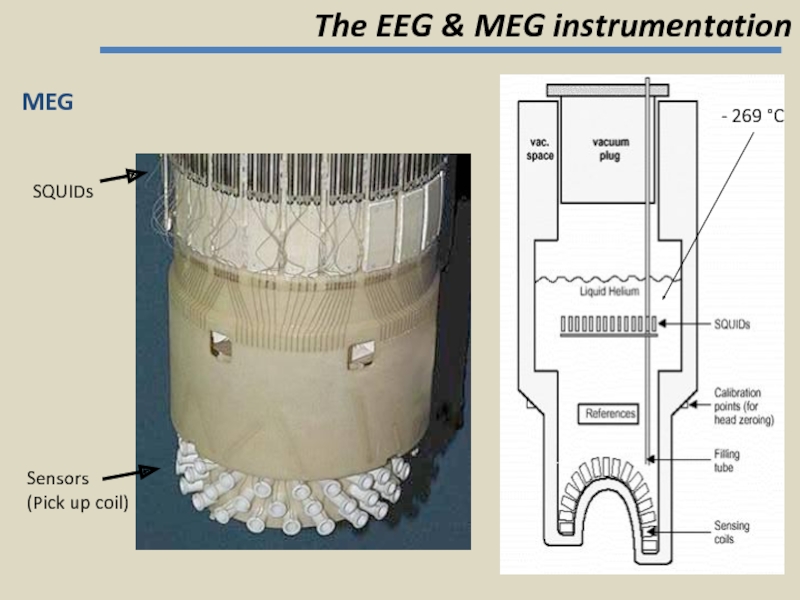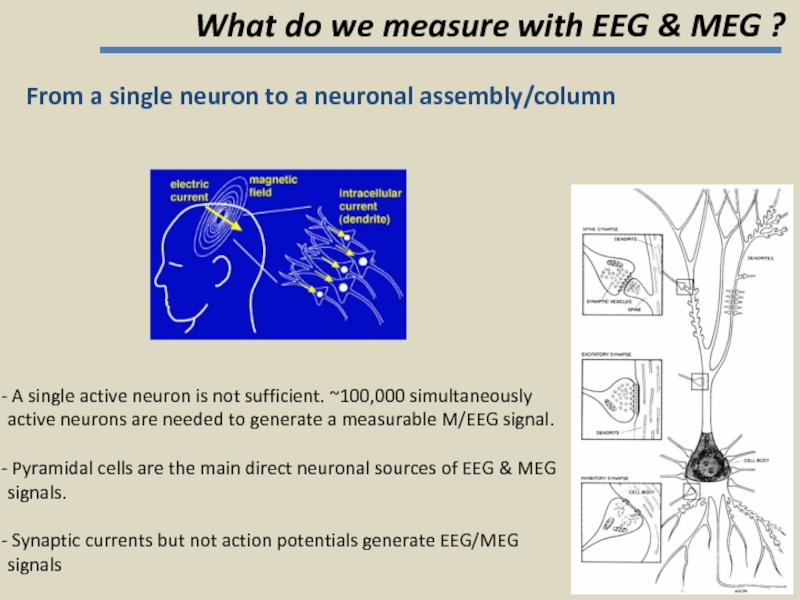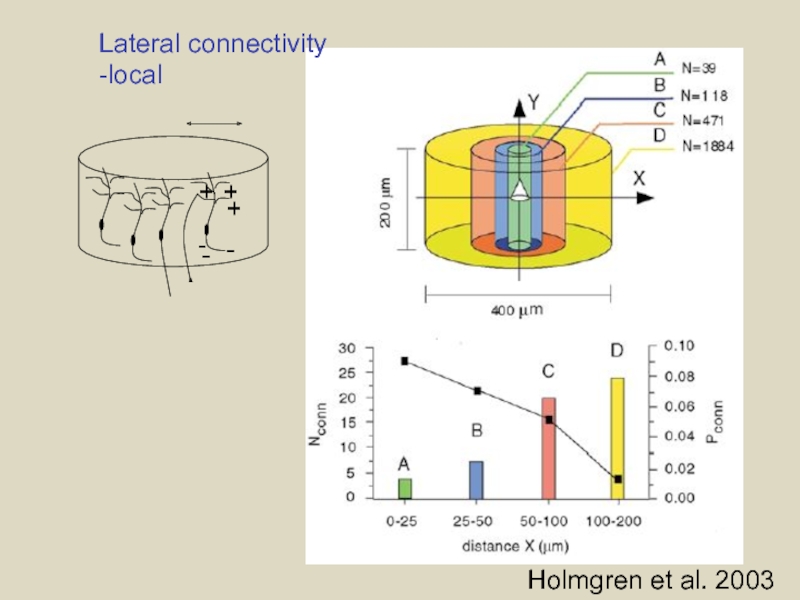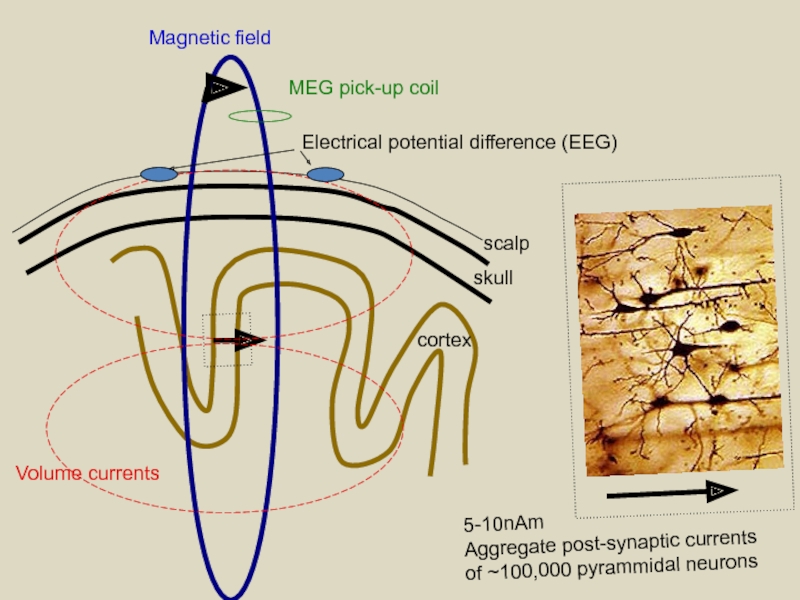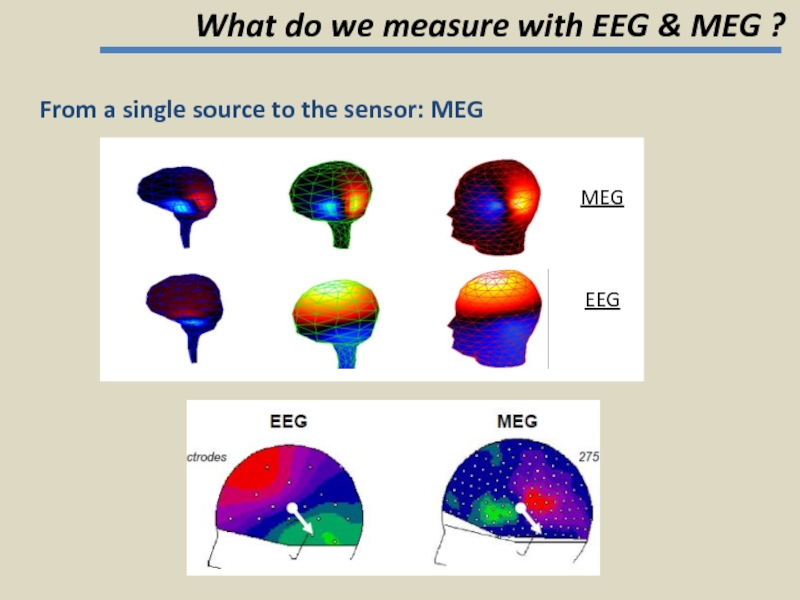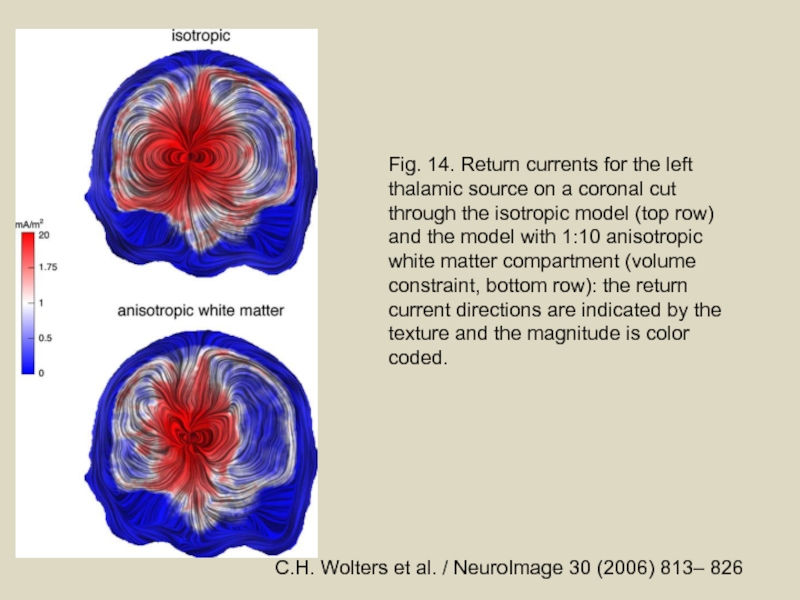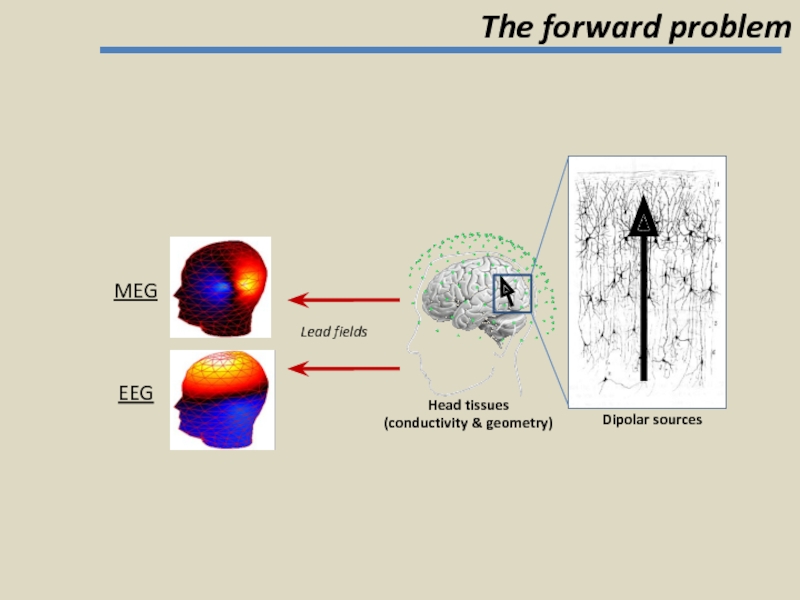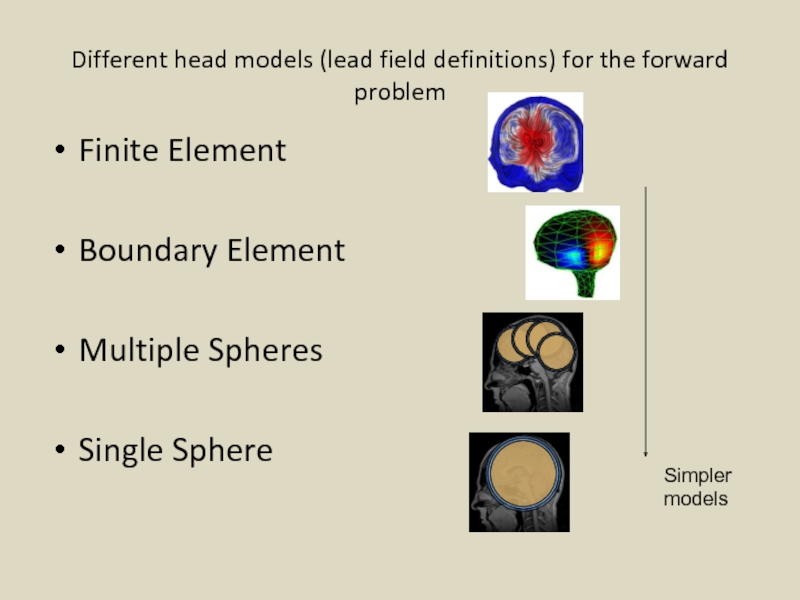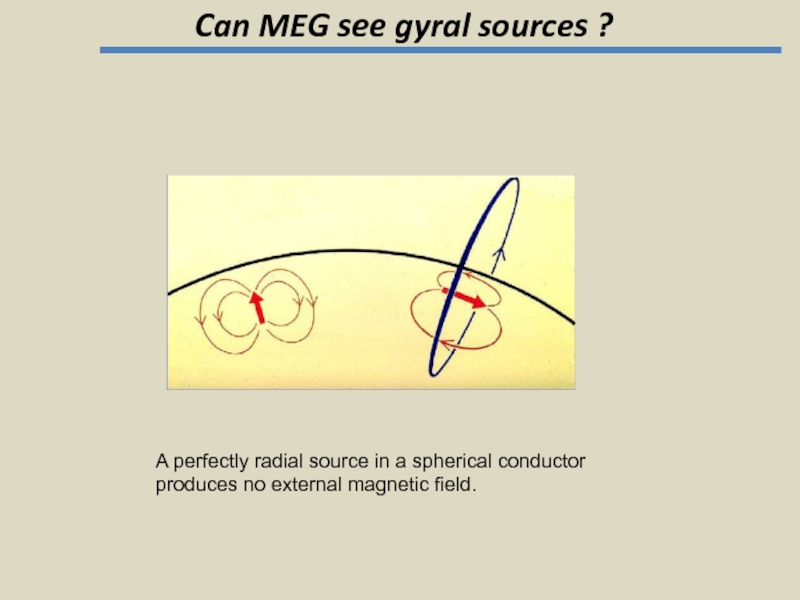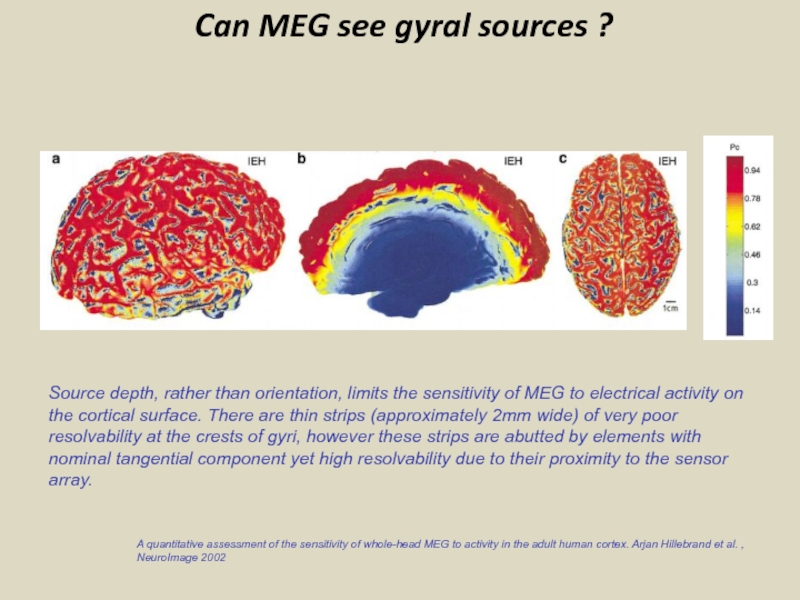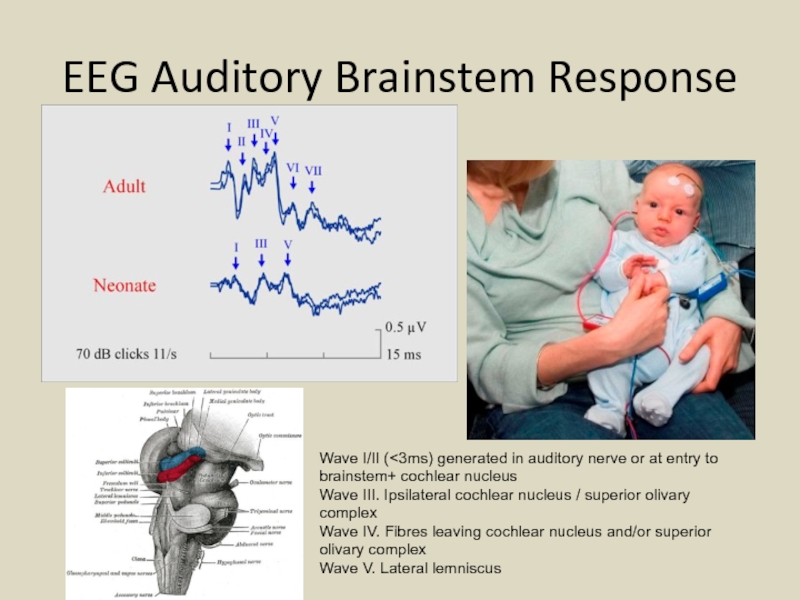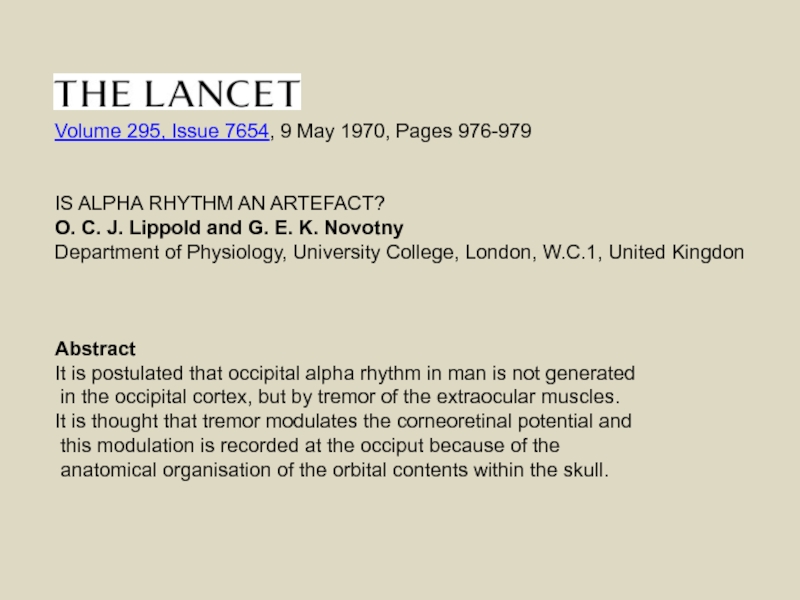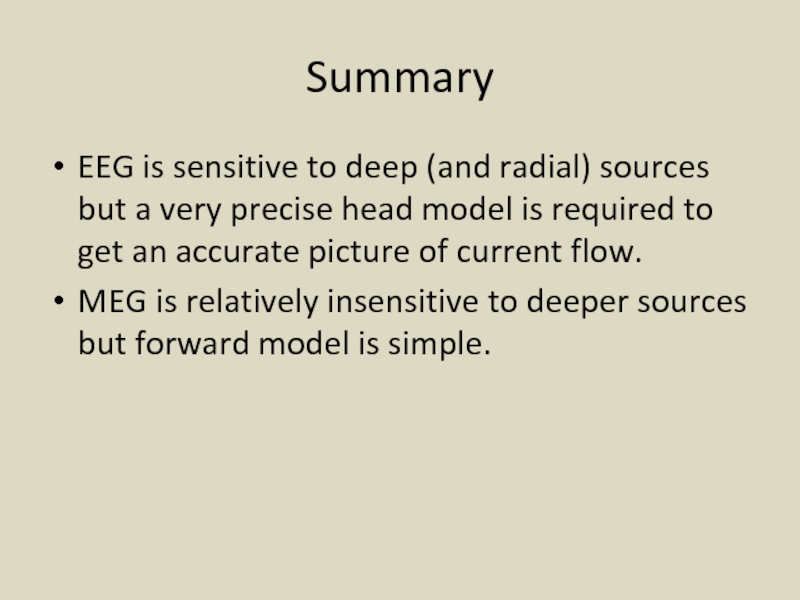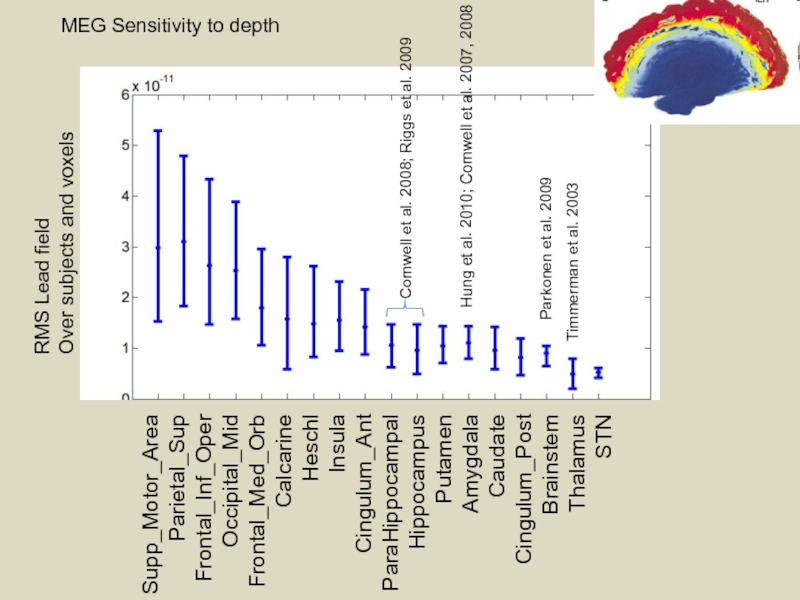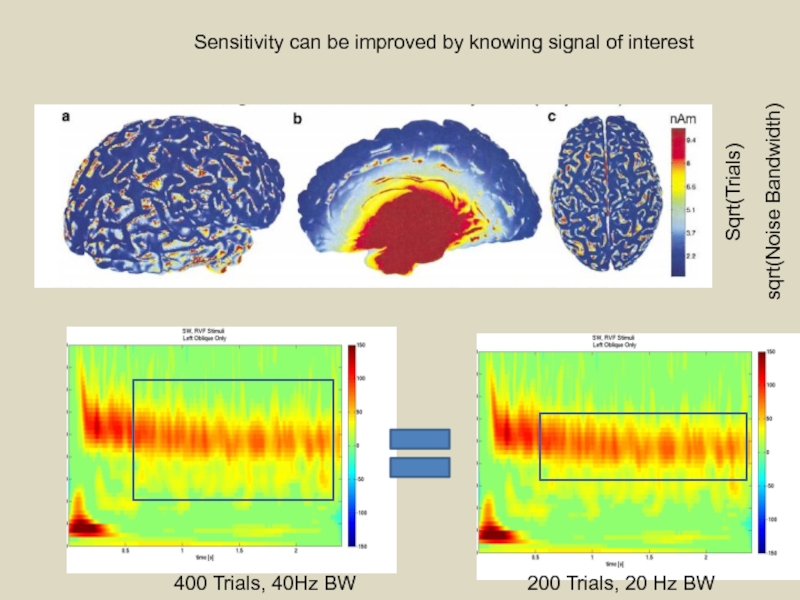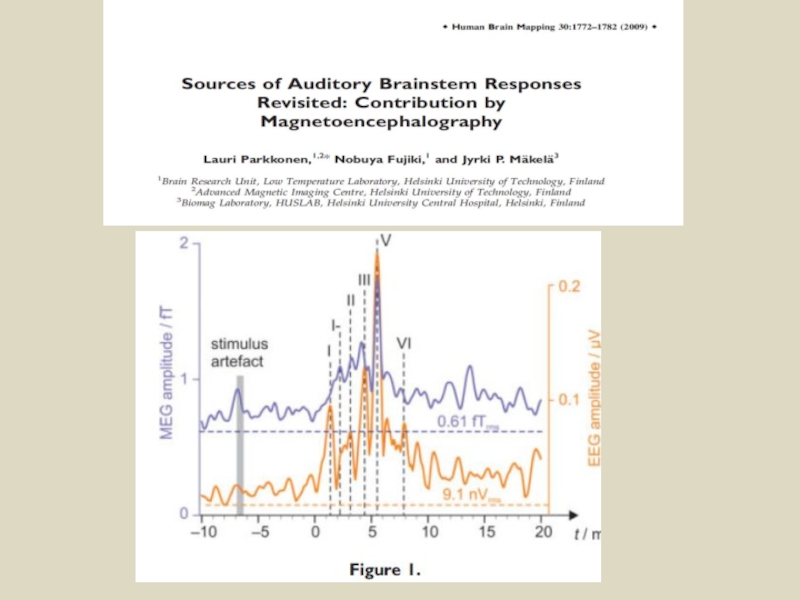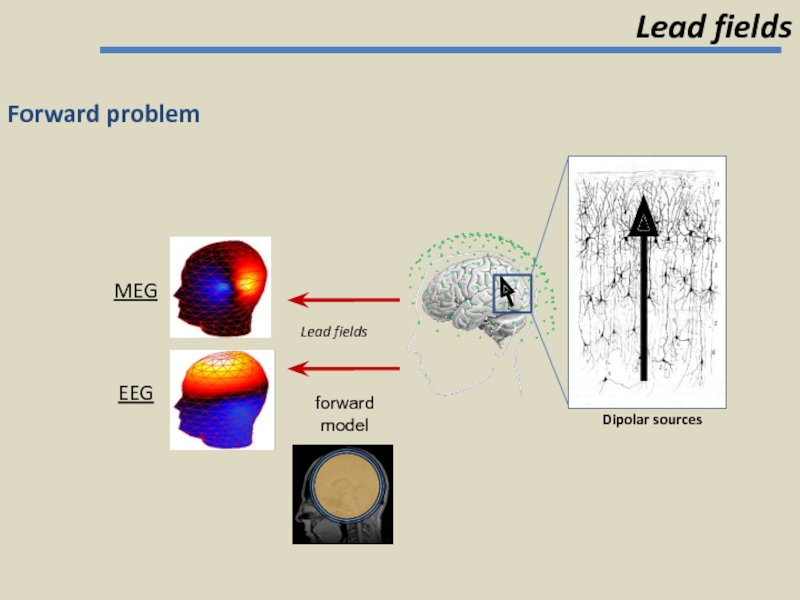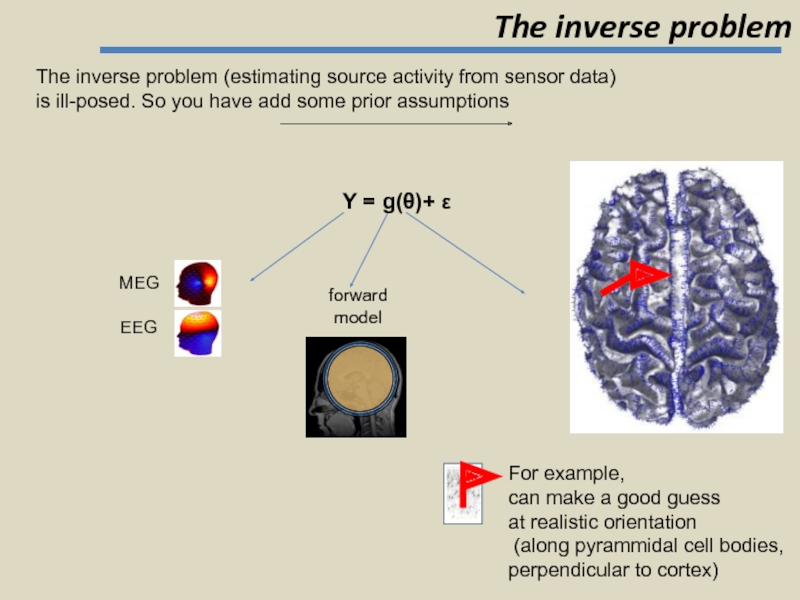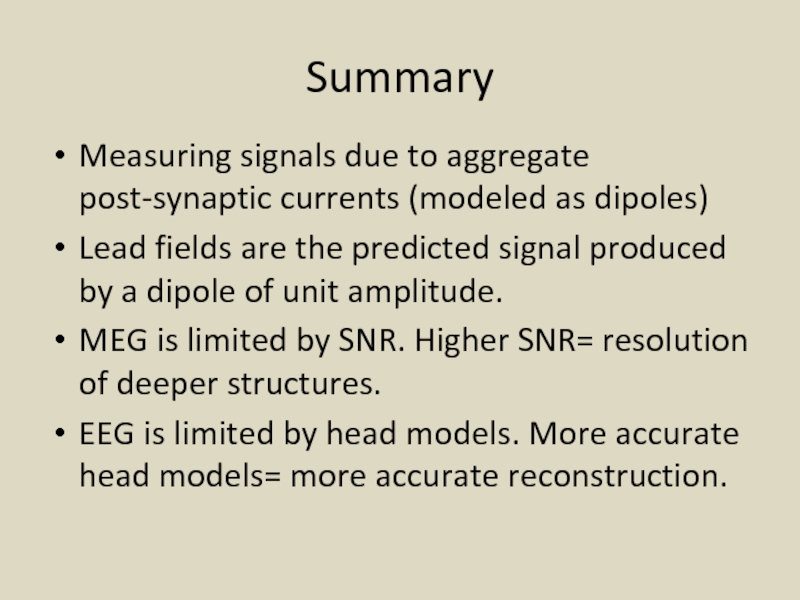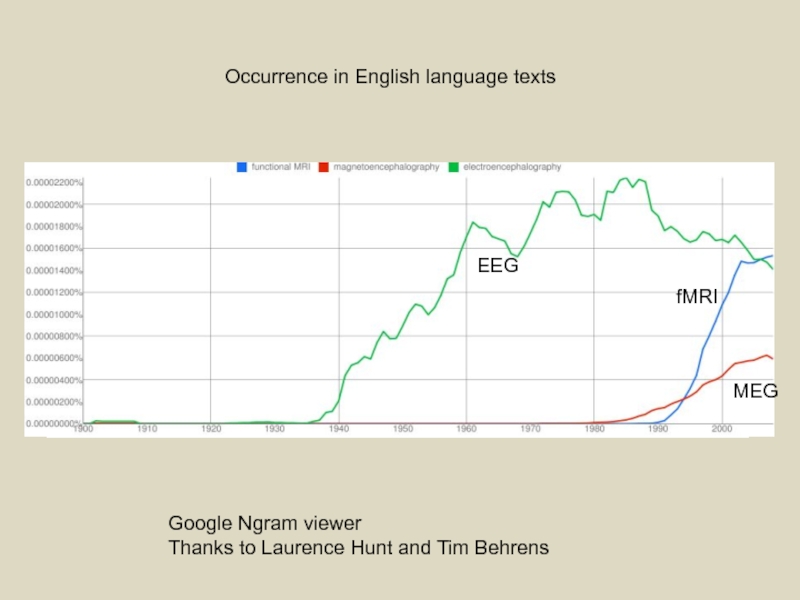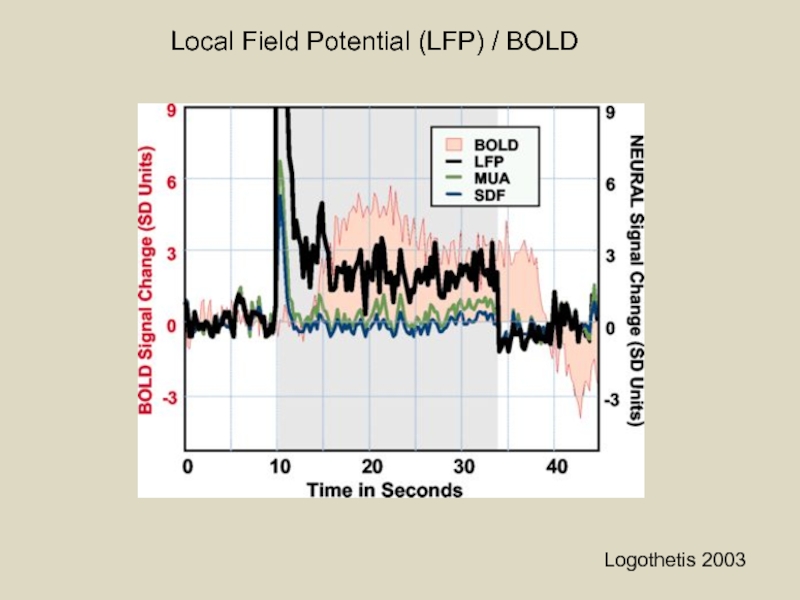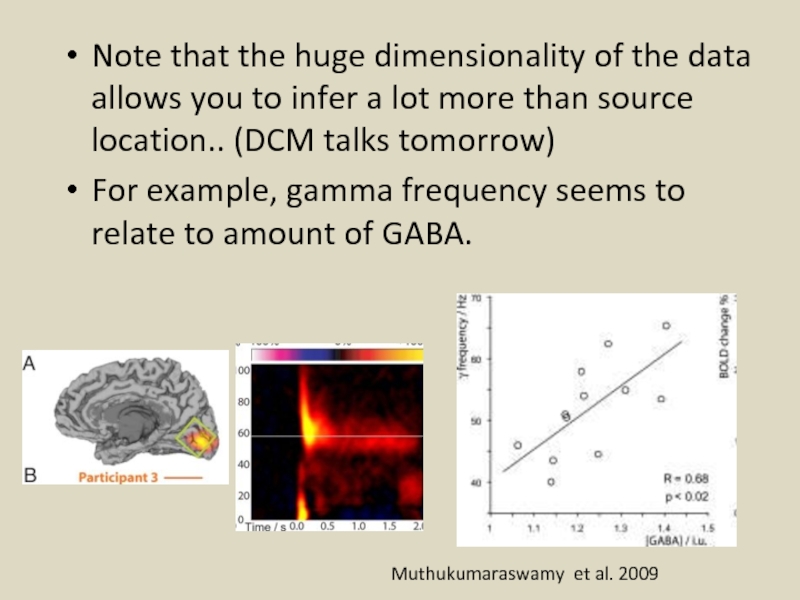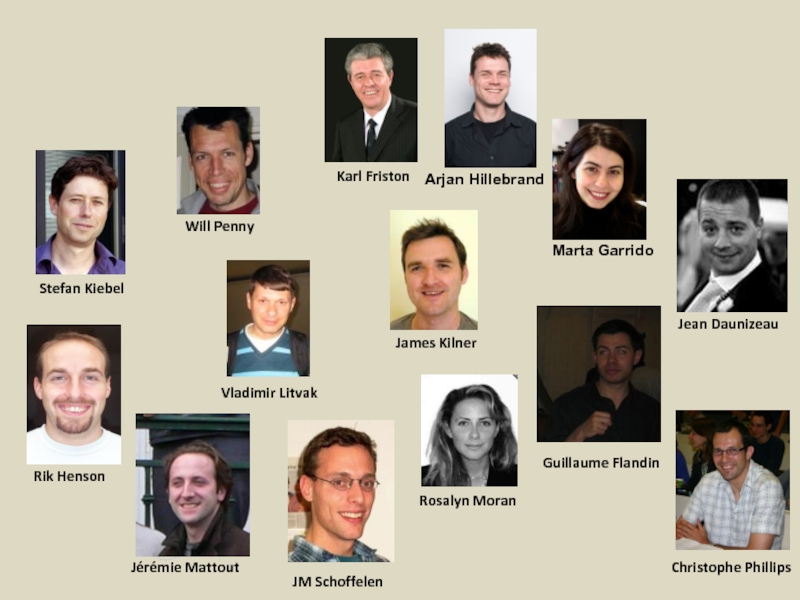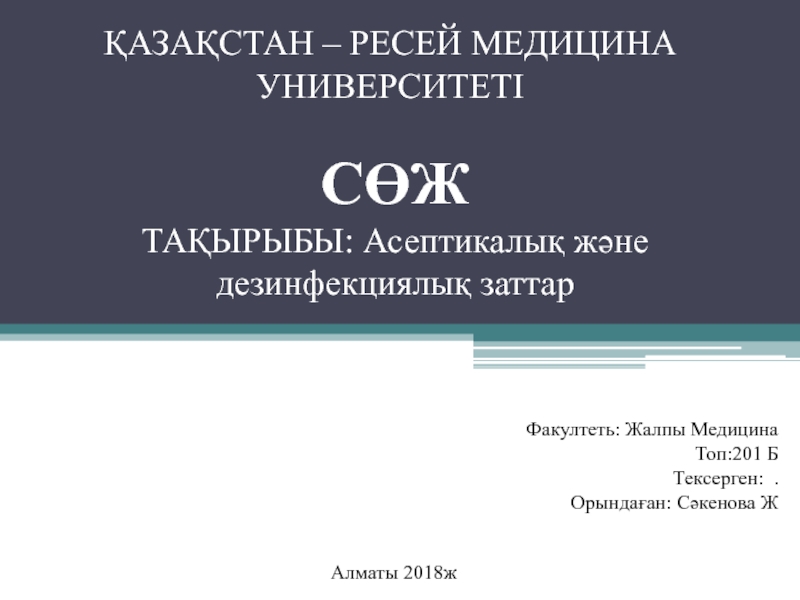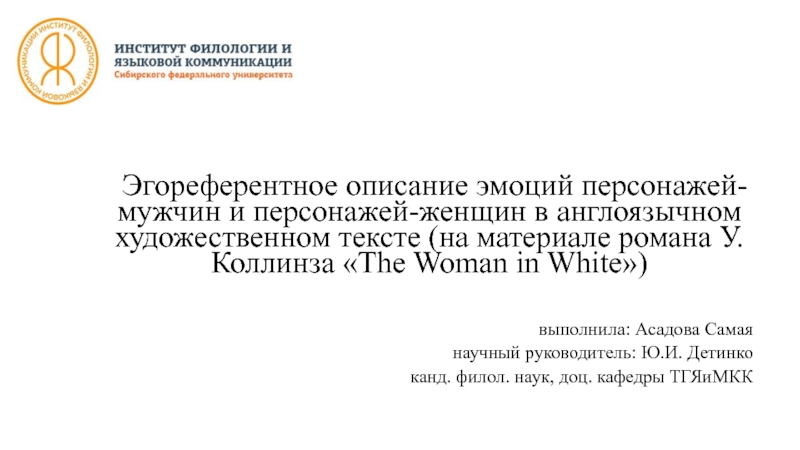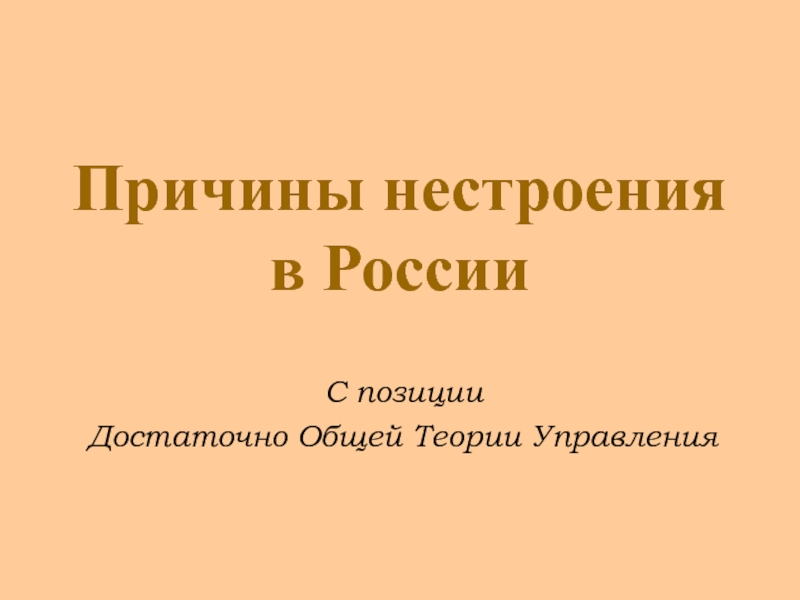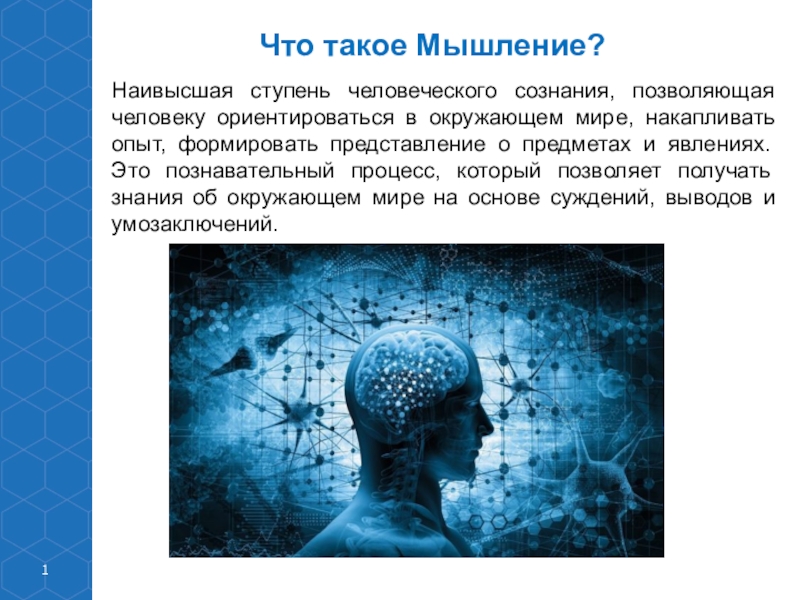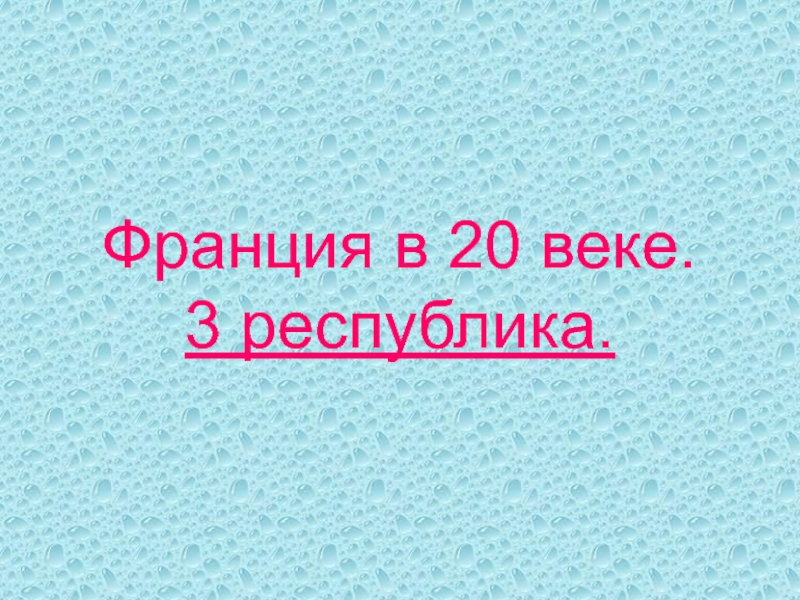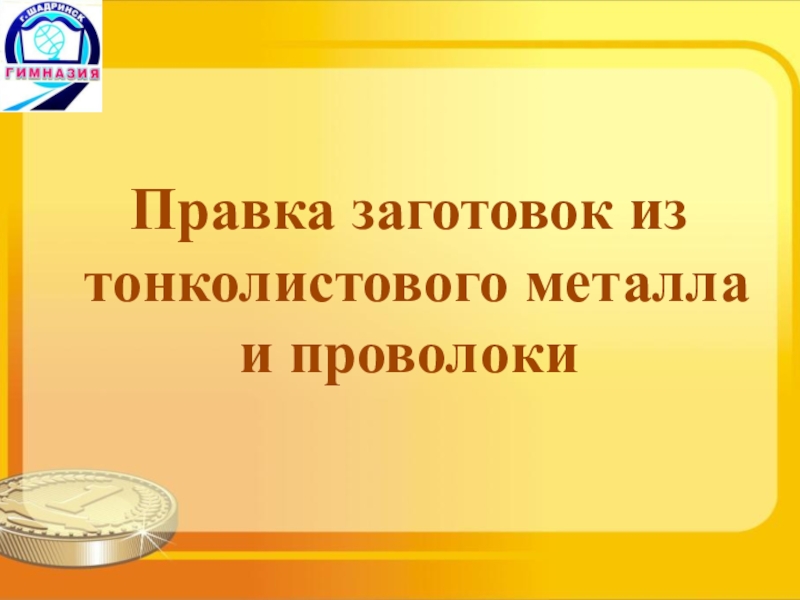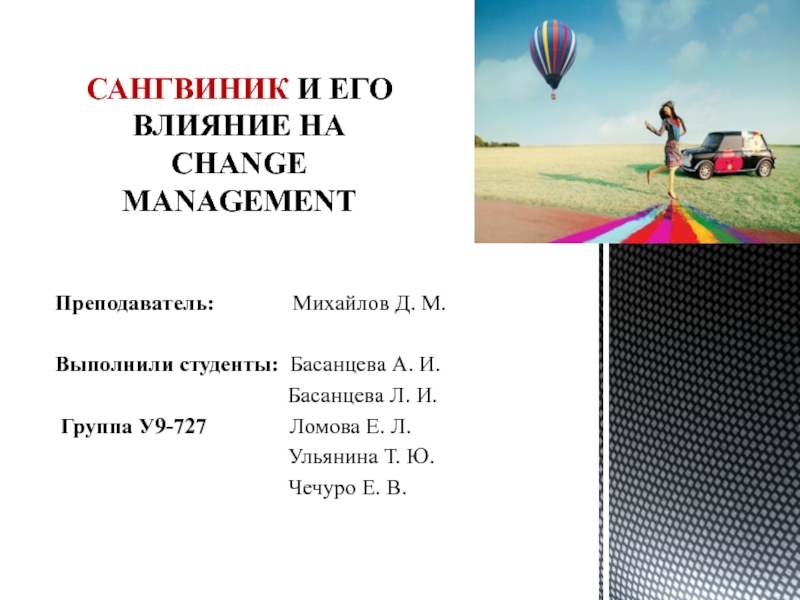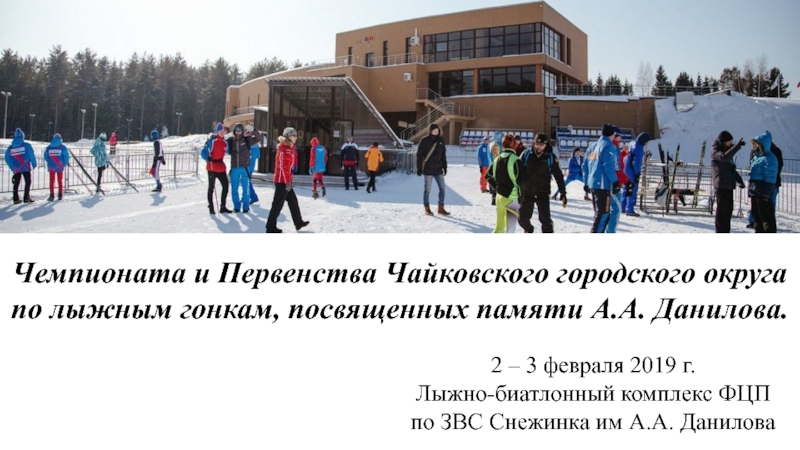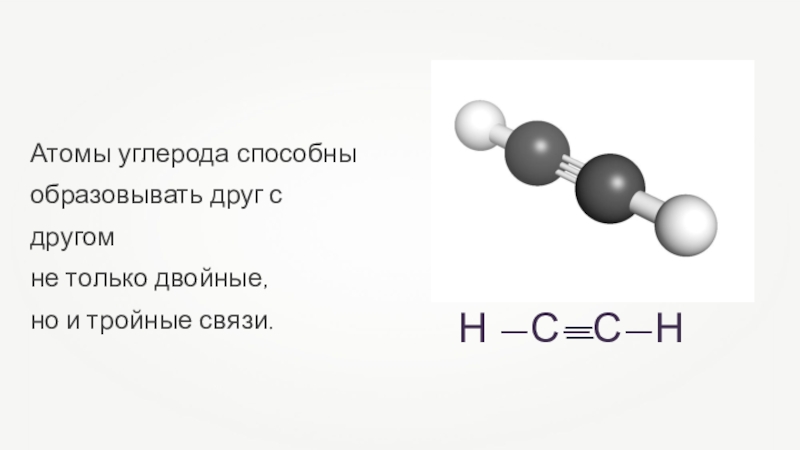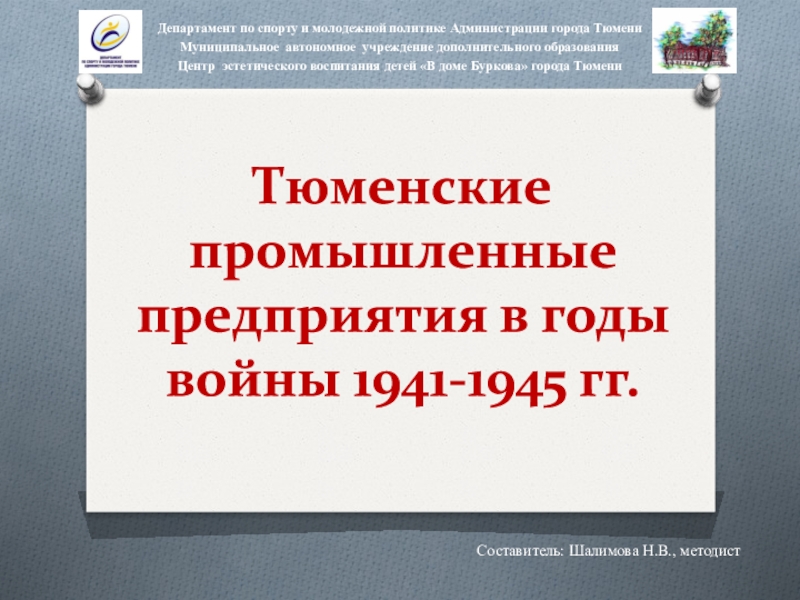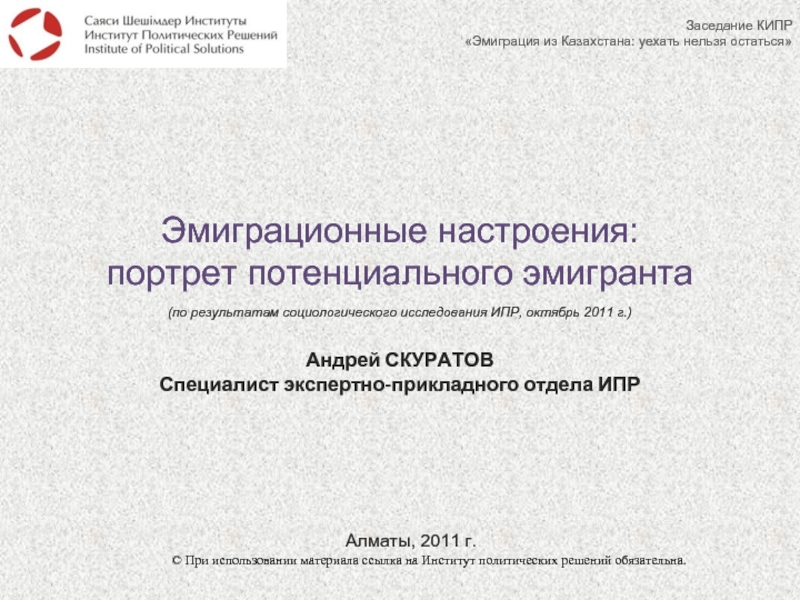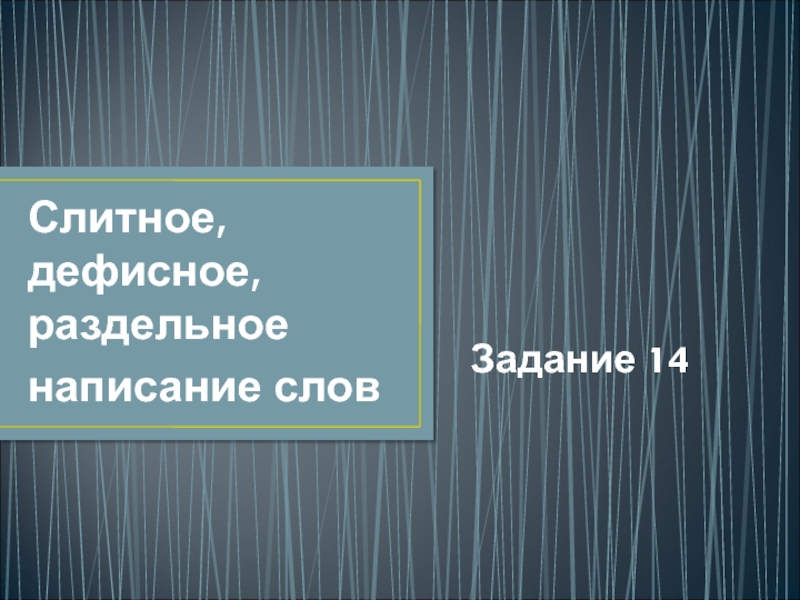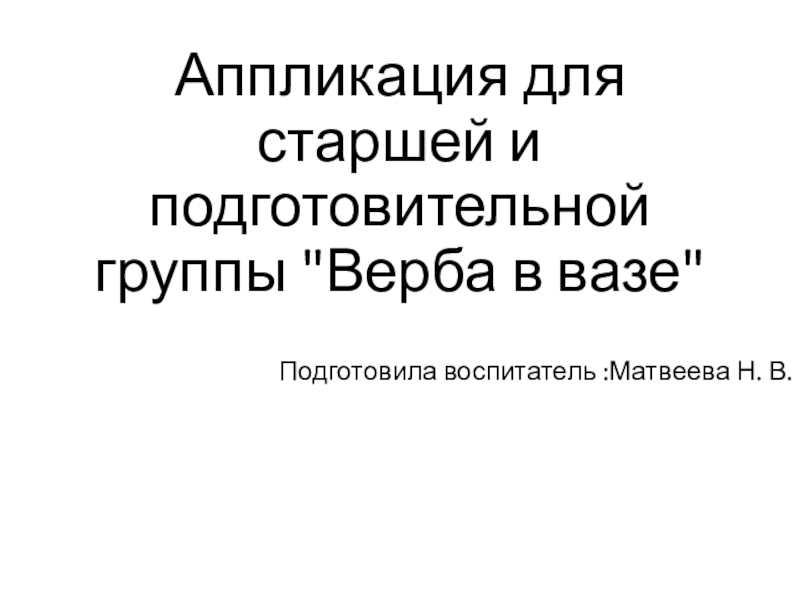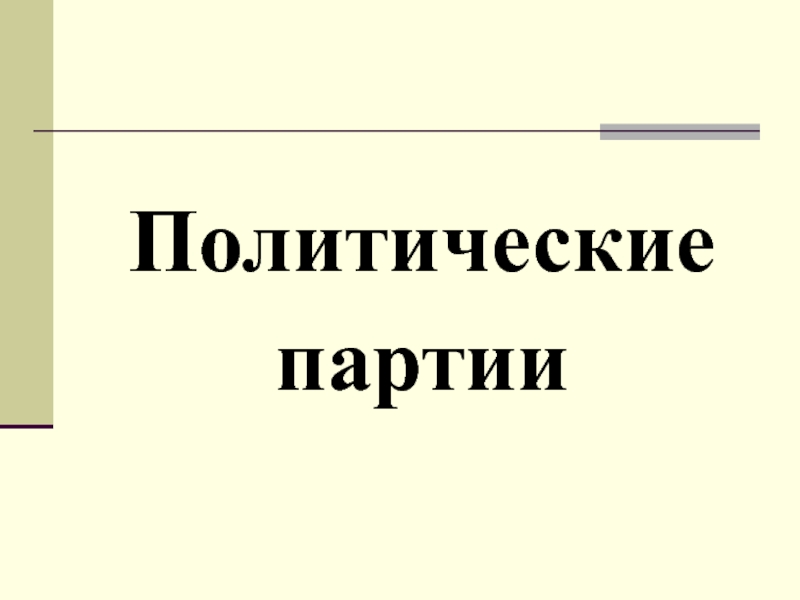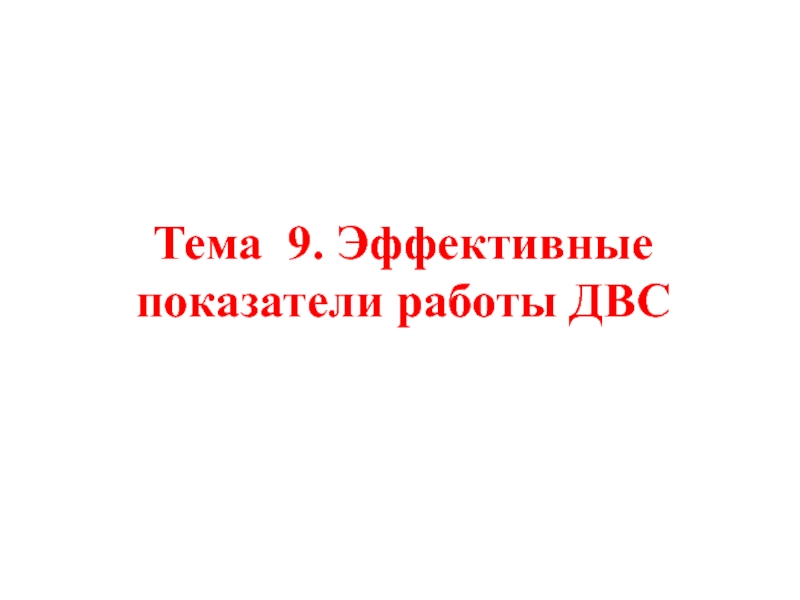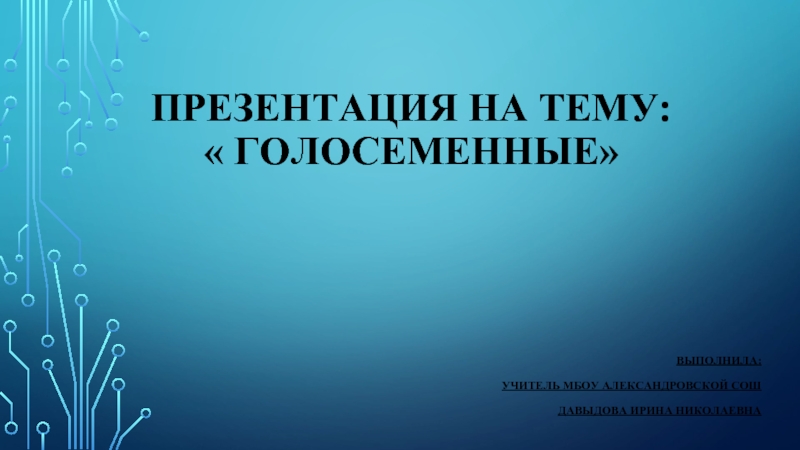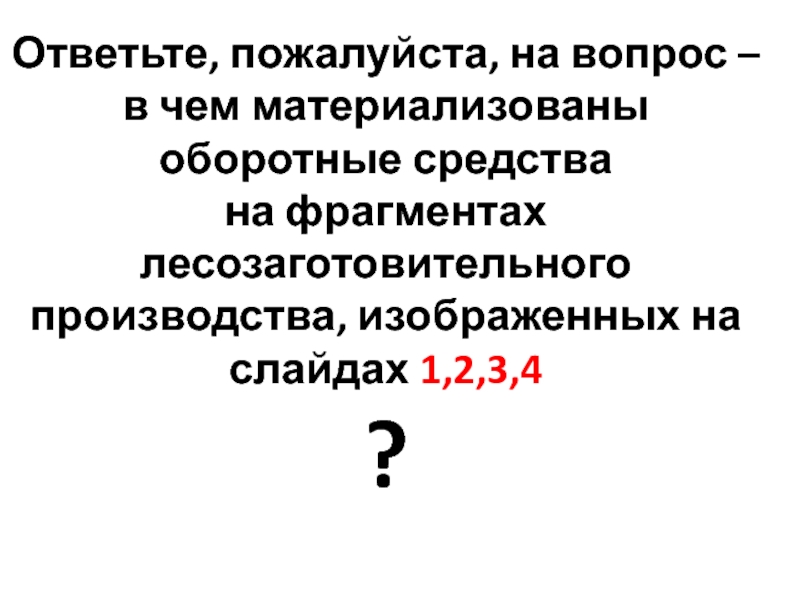Разделы презентаций
- Разное
- Английский язык
- Астрономия
- Алгебра
- Биология
- География
- Геометрия
- Детские презентации
- Информатика
- История
- Литература
- Математика
- Медицина
- Менеджмент
- Музыка
- МХК
- Немецкий язык
- ОБЖ
- Обществознание
- Окружающий мир
- Педагогика
- Русский язык
- Технология
- Физика
- Философия
- Химия
- Шаблоны, картинки для презентаций
- Экология
- Экономика
- Юриспруденция
What are we measuring with M/EEG (and what are we measuring with) Gareth
Содержание
- 1. What are we measuring with M/EEG (and what are we measuring with) Gareth
- 2. A brief historyThe EEG & MEG instrumentationNeuronal basis of the signalForward modelsOutline
- 3. EEG history1875: Richard Caton (1842-1926) measured currents
- 4. MEG historyDavidCohen1962: Josephson effect1968: first (noisy) measure
- 5. It is an ultrasensitive detector of magnetic
- 6. There are different types of sensorsMagnetometers: measure
- 7. Слайд 7
- 8. The EEG & MEG instrumentationSensors(Pick up coil)SQUIDsMEG- 269 °C
- 9. From a single neuron to a neuronal
- 10. Holmgren et al. 2003Lateral connectivity-local
- 11. Volume currentsMagnetic fieldElectrical potential difference (EEG)5-10nAmAggregate post-synaptic currents of ~100,000 pyrammidal neuronscortexskullscalpMEG pick-up coil
- 12. MEGEEGWhat do we measure with EEG & MEG ?From a single source to the sensor: MEG
- 13. Fig. 14. Return currents for the left
- 14. Lead fieldsMEGEEGDipolar sourcesHead tissues(conductivity & geometry)The forward problem
- 15. Different head models (lead field definitions) for the forward problemFinite ElementBoundary ElementMultiple SpheresSingle SphereSimplermodels
- 16. Can MEG see gyral sources ?A perfectly
- 17. A quantitative assessment of the sensitivity of
- 18. EEG Auditory Brainstem ResponseWave I/II (
- 19. Volume 295, Issue 7654, 9 May
- 20. SummaryEEG is sensitive to deep (and radial)
- 21. Supp_Motor_AreaParietal_SupFrontal_Inf_OperOccipital_MidFrontal_Med_OrbCalcarineHeschlInsula Cingulum_AntParaHippocampalHippocampusPutamenAmygdalaCaudateCingulum_PostBrainstemThalamusSTN Hung et al. 2010; Cornwell
- 22. Sqrt(Trials)sqrt(Noise Bandwidth)400 Trials, 40Hz BW200 Trials, 20
- 23. Слайд 23
- 24. Forward problemLead fieldsMEGEEGDipolar sourcesLead fieldsforwardmodel
- 25. Y = g()+ forwardmodelMEGThe inverse problemFor
- 26. SummaryMeasuring signals due to aggregate post-synaptic currents
- 27. Google Ngram viewerThanks to Laurence Hunt and Tim BehrensOccurrence in English language textsEEGfMRIMEG
- 28. Logothetis 2003Local Field Potential (LFP) / BOLD
- 29. Note that the huge dimensionality of the
- 30. Jean DaunizeauKarl FristonJames KilnerStefan KiebelGuillaume FlandinVladimir LitvakChristophe PhillipsRik HensonMarta GarridoWill PennyRosalyn MoranJérémie MattoutJM SchoffelenArjan Hillebrand
- 31. Скачать презентанцию
Слайды и текст этой презентации
Слайд 2A brief history
The EEG & MEG instrumentation
Neuronal basis of the
signal
Forward models
Outline
Слайд 3EEG history
1875: Richard Caton (1842-1926) measured currents inbetween the cortical
surface and the skull, in dogs and monkeys
1929: Hans Berger
(1873-1941) first EEG in humans (his young son), description of alpha and beta waves1950s. Grey Walter ( 1910 – 1977). Invention of topographic EEG maps.
Слайд 4MEG history
David
Cohen
1962: Josephson effect
1968: first (noisy) measure of a magnetic
brain signal [Cohen, Science 68]
1970: James Zimmerman invents the ‘Superconducting quantum interference device’
(SQUID)1972: first (1 sensor) MEG recording based on SQUID [Cohen, Science 1972]
1973: Josephson wins the Nobel Prize in Physics
- And goes on to study paranormal activity…
Brian-David
Josephson
Слайд 5
It is an ultrasensitive detector of magnetic flux.
It is made
up of a superconducting ring interrupted by one or two
Josephson Junctions.Can measure field changes of the order of 10^-15 (femto) Tesla
(compare to the earth’s field of 10^-4 Tesla)
SQUIDS
Слайд 6There are different types of sensors
Magnetometers: measure the magnetic flux
through a single coil
Gradiometers: when more flux passes through the
lower coil (near the head) than the upper get a net change in current flow at the inut coil.Flux transformers
Слайд 9From a single neuron to a neuronal assembly/column
A single
active neuron is not sufficient. ~100,000 simultaneously active neurons are
needed to generate a measurable M/EEG signal.Pyramidal cells are the main direct neuronal sources of EEG & MEG signals.
Synaptic currents but not action potentials generate EEG/MEG signals
What do we measure with EEG & MEG ?
Слайд 11Volume currents
Magnetic field
Electrical potential difference (EEG)
5-10nAm
Aggregate post-synaptic currents
of ~100,000
pyrammidal neurons
cortex
skull
scalp
MEG pick-up coil
Слайд 13Fig. 14. Return currents for the left thalamic source on
a coronal cut through the isotropic model (top row) and
the model with 1:10 anisotropic white matter compartment (volume constraint, bottom row): the return current directions are indicated by the texture and the magnitude is color coded.C.H. Wolters et al. / NeuroImage 30 (2006) 813– 826
Слайд 15Different head models (lead field definitions) for the forward problem
Finite
Element
Boundary Element
Multiple Spheres
Single Sphere
Simpler
models
Слайд 16Can MEG see gyral sources ?
A perfectly radial source in
a spherical conductor
produces no external magnetic field.
Слайд 17A quantitative assessment of the sensitivity of whole-head MEG to
activity in the adult human cortex. Arjan Hillebrand et al.
,NeuroImage 2002
Source depth, rather than orientation, limits the sensitivity of MEG to electrical activity on the cortical surface. There are thin strips (approximately 2mm wide) of very poor resolvability at the crests of gyri, however these strips are abutted by elements with nominal tangential component yet high resolvability due to their proximity to the sensor array.
Can MEG see gyral sources ?
Слайд 18EEG Auditory Brainstem Response
Wave I/II (
or at entry to brainstem+ cochlear nucleus
Wave III. Ipsilateral cochlear
nucleus / superior olivary complexWave IV. Fibres leaving cochlear nucleus and/or superior olivary complex
Wave V. Lateral lemniscus
Слайд 19
Volume 295, Issue 7654, 9 May 1970, Pages 976-979
IS
ALPHA RHYTHM AN ARTEFACT?
O. C. J. Lippold and G.
E. K. NovotnyDepartment of Physiology, University College, London, W.C.1, United Kingdon
Abstract
It is postulated that occipital alpha rhythm in man is not generated
in the occipital cortex, but by tremor of the extraocular muscles.
It is thought that tremor modulates the corneoretinal potential and
this modulation is recorded at the occiput because of the
anatomical organisation of the orbital contents within the skull.
Слайд 20Summary
EEG is sensitive to deep (and radial) sources but a
very precise head model is required to get an accurate
picture of current flow.MEG is relatively insensitive to deeper sources but forward model is simple.
Слайд 21Supp_Motor_Area
Parietal_Sup
Frontal_Inf_Oper
Occipital_Mid
Frontal_Med_Orb
Calcarine
Heschl
Insula
Cingulum_Ant
ParaHippocampal
Hippocampus
Putamen
Amygdala
Caudate
Cingulum_Post
Brainstem
Thalamus
STN
Hung et al. 2010; Cornwell et al. 2007,
2008
Parkonen et al. 2009
Cornwell et al. 2008; Riggs et
al. 2009RMS Lead field
Over subjects and voxels
Timmerman et al. 2003
MEG Sensitivity to depth
Слайд 22
Sqrt(Trials)
sqrt(Noise Bandwidth)
400 Trials, 40Hz BW
200 Trials, 20 Hz BW
Sensitivity can
be improved by knowing signal of interest
Слайд 25Y = g()+
forward
model
MEG
The inverse problem
For example,
can make
a good guess
at realistic orientation
(along pyrammidal cell bodies,
perpendicular to cortex)
EEG
The inverse problem (estimating source activity from sensor data)
is ill-posed. So you have add some prior assumptions
Слайд 26Summary
Measuring signals due to aggregate post-synaptic currents (modeled as dipoles)
Lead
fields are the predicted signal produced by a dipole of
unit amplitude.MEG is limited by SNR. Higher SNR= resolution of deeper structures.
EEG is limited by head models. More accurate head models= more accurate reconstruction.
Слайд 27Google Ngram viewer
Thanks to Laurence Hunt and Tim Behrens
Occurrence in
English language texts
EEG
fMRI
MEG
Слайд 29Note that the huge dimensionality of the data allows you
to infer a lot more than source location.. (DCM talks
tomorrow)For example, gamma frequency seems to relate to amount of GABA.
Muthukumaraswamy et al. 2009
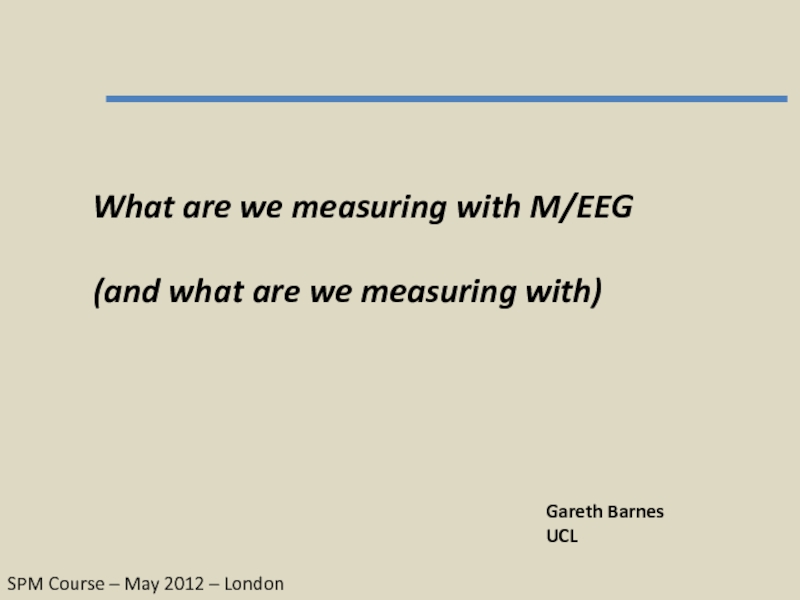
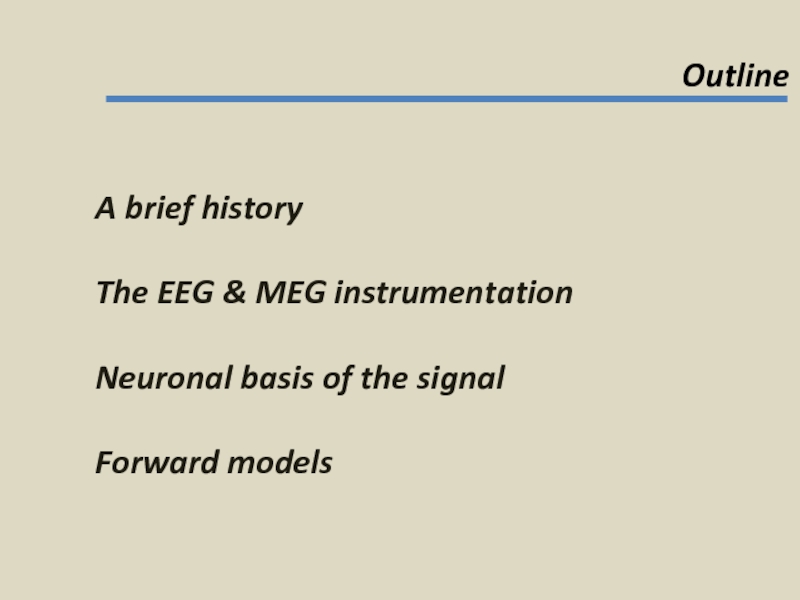
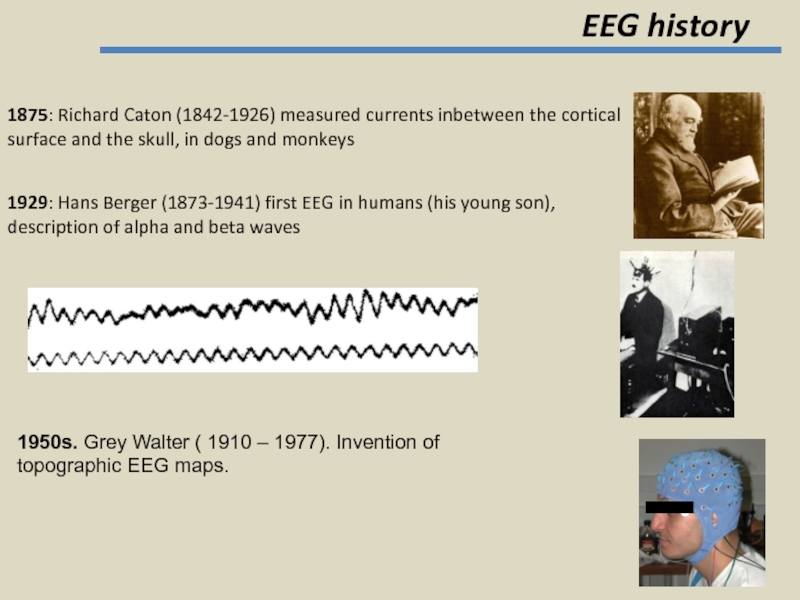
![What are we measuring with M/EEG
(and what are we measuring with)
Gareth MEG historyDavidCohen1962: Josephson effect1968: first (noisy) measure of a magnetic brain MEG historyDavidCohen1962: Josephson effect1968: first (noisy) measure of a magnetic brain signal [Cohen, Science 68]1970: James Zimmerman](/img/tmb/3/287597/d975cbf5626c368391e52d9a0bbeb2bb-800x.jpg)
